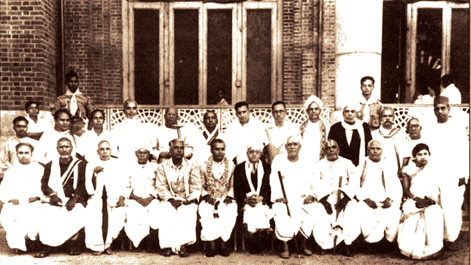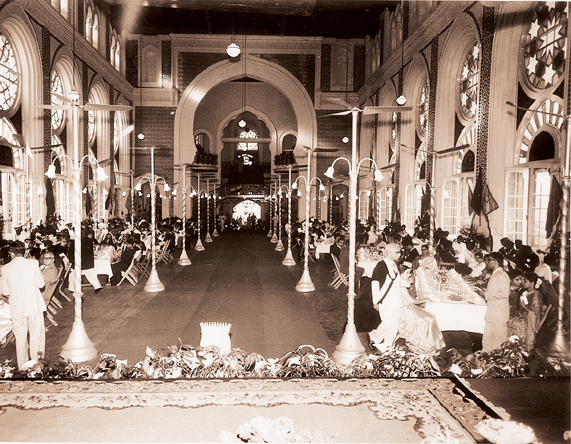
It was at the Senate House that the December Music Season of Chennai had its genesis. The Academy sessions, numerous meetings, dance recitals and music performances were held in Senate House. Above, the 1939 Music Academy conference: Seated 6th from left, Musiri Subramania Iyer, 7th K.V. Krishnaswami Iyer, 8th Harikesanallur Muthiah Bhaghavatar, 9th 'Tiger' Varadachariar, to be the first head of the University's Department of Indian Music. Standing: 2nd left, Tanjore Vaidyanatha Iyer, 4th Budalur
Krishnamoorthy Sastrigal, 10th T.L. Venkatarama Iyer, 11th T.V. Subha Rao.
The 1939 Season posed a new challenge to the two major sabhas that conducted music and dance programmes in December – the Music Academy and the Indian Fine Arts Society (IFAS). With the commencement of World War II, restrictions were imposed on holding large public meetings in open pandals. The previous year, the two organisations had decided to conduct their conference (morning sessions) jointly and these were held in the garden of the Woodlands Hotel in Royapettah. The Academy held its concerts also at the same venue, while the IFAS had them at Gokhale Hall, Armenian Street. In 1939, what with war economies also being in place, the two sabhas had to come closer – conference and concerts were to be organised jointly and that meant a new venue, large enough to accommodate members of both sabhas.
Gokhale Hall, the IFAS venue, was ruled out as it could not accommodate the large audience regularly turning out for the Season. It was left to K.V. Krishnaswamy Iyer, the dynamic president of the Music Academy, to find a way out. As a member of the Syndicate of the University of Madras, he was able to obtain sanction to conduct the Season at Senate House. There were howls of protest when the announcement was made, for everyone, including Prof. P. Sambamoorthy, complained about the poor acoustics in the great hall of Senate House. The location on South Beach Road also made it inaccessible to public transport, especially in the late hours of the evening when the second concert would get over. There were also no eateries in the vicinity.
But once he had made a decision, there was no turning back for KVK. He, however, did seriously address all issues. Cloth canopies and hangings were designed, stitched and put up which, together with loudspeakers, ensured that the music was heard well at the farthest ends of the great hall. As for transport, special bus arrangements were made connecting Senate House with Mylapore, Mambalam, Egmore, Purasawalkam and George Town. Season tickets at Rs. 2-As 4 were also made available for availing of the bus service.
The Udipi Gopalakrishna Lunch Home, which functioned next to the Academy’s registered office on Thambu Chetty Street, the official caterer for the Season, set up a kitchen in the gardens of Senate House to take care of nourishment. This marked the beginning of the canteen culture, which is such an integral part of the Season today.
As an additional attraction and taking advantage of the vast amount of space that Senate House offered, an exhibition of music works, manuscripts and instruments was planned in cooperation with the University of Madras, the Government Oriental Manuscripts Library, Madras, the Sri Venkateswara Oriental Institute, Tirupati, and the Madras Government Museum. Prof. P. Sambamoorthy helped in coordinating this activity along with T.V. Subba Rao. The Academy also put out advertisements requesting private collectors to come forward and participate in the exhibition.
This was also the conference where Travancore royalty took a personal interest. The regency of Sethu Lakshmi Bayi had ended in 1931 and her nephew, Chitra Tirunal Balarama Varma, had taken over as the Maharaja. His mother, the Junior Maharani Sethu Parvati Bayi, together with Sir C.P. Ramaswami Iyer, who in stages graduated from being her Legal Advisor to Constitutional Advisor and finally Dewan of the state in 1937, was the real power behind the throne. The lady had long desired to resurrect and propagate the songs of the composer-king Swati Tirunal of Travancore and, in September 1939, the Swati Tirunal Academy of Music was started with Harikesanallur Muthiah Bhagavatar as its head. Assisting him was Semmangudi Srinivasa Iyer, their main task being the identification and collection of Swati Tirunal’s songs, popularising the singing of those that already had tunes, setting to tune the songs for which only lyrics were available and, finally, ensuring that musicians featured them regularly in concerts. The Music Academy was happy to help and decided to dedicate December 29, 1939 to the “rendering and exposition of the compositions of the late Maharajah Swati Tirunal by the musicians present.”

The Senate House interior as it was in the 1920s and 1930s.
The conference, it was announced on October 24th, would be inaugurated by Sir R.K. Shanmukham Chetti. The Cochin Royal Family, whose Dewan Sir Shanmukham was, also took an interest in the conference. The inaugural concert was to be performed by Princess Manku Tampuran of Cochin. It was the first time that a woman of royal blood was performing a music concert in public and this generated great interest.
The choice of musician for presiding over the conference, however, raised a few eyebrows and hackles. Musiri Subramania Iyer at the age of 39, it was felt, was too young for the job, though none could deny that he was top draw as far as popularity was concerned. He had a unique style of slow emotive music which, combined with his unusually high-pitched voice, had electrified audiences for over two decades.
But, with several seniors in the field not yet honoured, it was felt that Musiri had jumped the queue. Chembai Vaidyanatha Bhagavatar, who had been performing from a very young age and was, therefore, senior in terms of career to even Ariyakudi Ramanuja Iyengar, was most offended. But with his own disciple Princess Manku Tampuran performing, he had no choice but to attend the inauguration. To add insult to injury, Chembai was asked to felicitate Musiri. In his characteristic fashion the titan from Palghat strode to the microphone and said that he was delighted that the Music Academy had chosen Musiri to preside. He then went on to say that it was his earnest wish that the Academy invite Musiri to preside over the conference every year from then on! Chembai was slated to sing on the 25th and it is not clear if he did. But what we do know is that he refused to have anything to do with the Music Academy from then on till 1945 or so when, through the intervention of admirers, he relented and returned.
Musiri inadvertently gave rise to a minor controversy himself when he was reported to have said in his presidential address that the divide between the North and South Indian music systems was inappropriate and that a synthesis between the two must be arrived at. This was severely criticised and Musiri had to issue a clarification that what he had meant was that the systems must co-exist in a spirit of mutual cooperation.
In keeping with its efforts to propagate dance, the Season’s schedule had three performances featuring Lakshmi Sastri, Kalanidhi Ganapathy and T. Balasaraswati. A new introduction by the Music Academy that year was the duo of Alathur Brothers. (Courtesy: Sruti)
|

